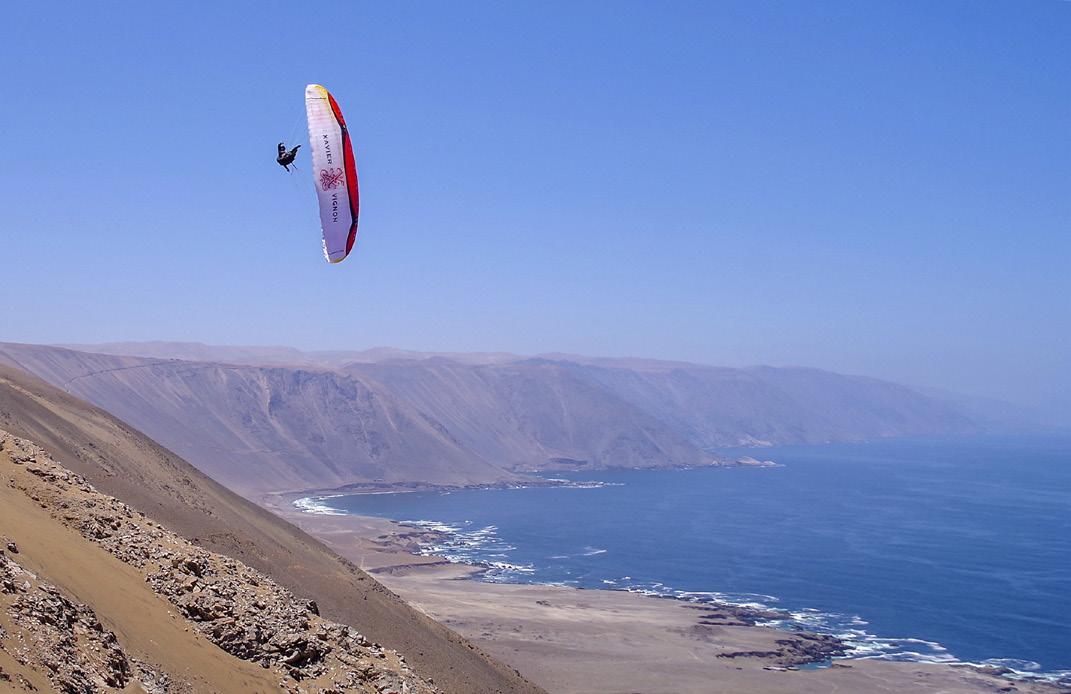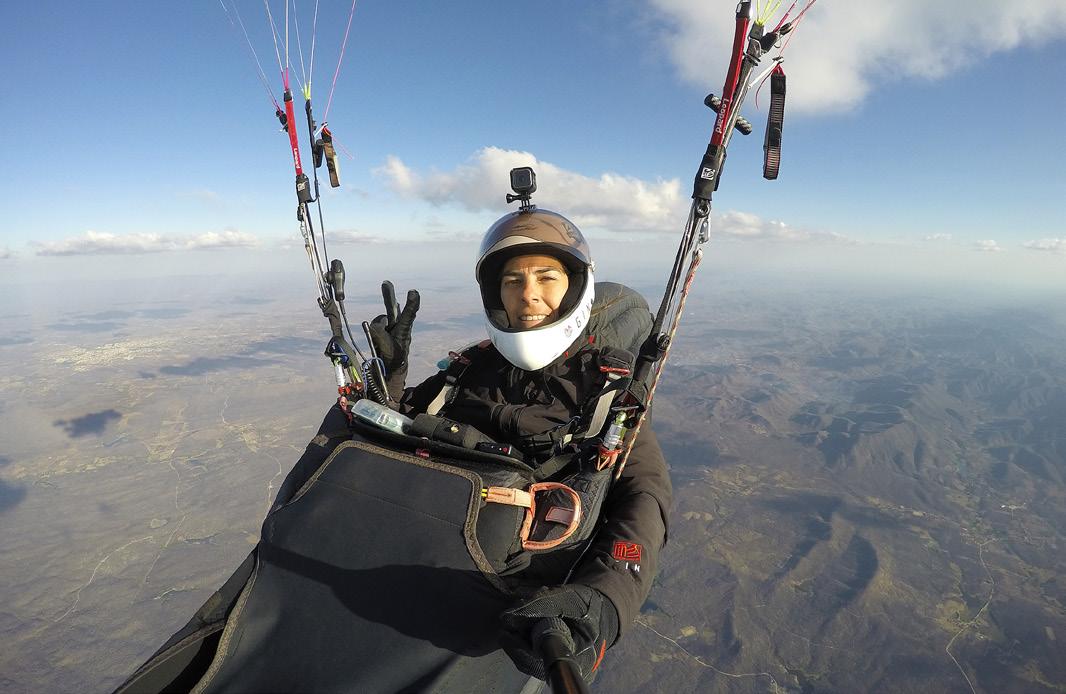
5 minute read
HOW TO... MAXIMISE AIRTIME

Photo: François Ragolski
HOW TO... MAXIMISE AIRTIME
Advertisement
“Where can you go to get guaranteed flying?”
If it rains or blows hard for a week, then your flying trip can be a write-off – and we all know the pain of that. There are only so many YouTube videos you can watch while wishing away the weather before your flying paradise fades to grey.
But it’s still a question that pilots ask, especially those keen to build hours after qualifying. They may have been lured in to parting with their hard-earned cash by promises of endless days, a sky dotted with cumulus clouds and six-hour flights every day. When the reality turns out to be four hours a day in a minibus chasing the wind, it can be disheartening.
The simplest way to avoid that type of situation is to stay flexible and check the weather for where the flying is looking good. That way, if it looks flyable in the French Alps but raining in the Austrian Alps, you go there. Plan your flying location to match the weather situation, just as you do at home. Yes, it will probably work out more expensive, but if you are sitting at cloudbase in France while your friends are sitting under umbrellas in Spain... well it’s priceless.
The second way is to look at the recent historical records for where you want to fly. There is so much data online that you can clearly see patterns in who flies when and where. Identify the best time for where you want to fly, then around that time start to watch the forecast. Once it’s looking good, make your move!
This doesn’t help if you are going long haul, or have to take holiday at a certain time. Then it’s back to the age-old question of “Where can you go to get guaranteed flying?” Then it’s about climate: what places with good flying infrastructure are good at what time of year. To help answer that one, we turned to the crowd on Cross Country’s social media channels for some suggestions on where pilots should go to get maximum airtime. From Brazil to Australia, everyone had a favourite spot. Here are some of them!

Photo: Cloudbase Paragliding
Wilderness, S. Africa
“Wilderness, South Africa,” said Grant Fairley, “You can fly until hunger takes you down.” And he’s right, the coastal sites along this stretch of the Garden Route in South Africa create a true free-flyers’ paradise when it’s on, with bluffs facing the ocean that allow hours and hours of flying.
It’s popular with tour groups who visit to escape European winter and finish off training. Sites like Map of Africa can see new pilots go from first flights to soaring for an hour in just three days. Inland thermalling sites are not far away either.
Four hours further along the coast the city of Hermanus has very accessible thermic flying within glide of wine country, and Cape Town itself is home to a busy tandem scene with paragliding above the city and landing on the beach.
For those who prefer their flying without the sea breeze, Porterville, two hours north east of Cape Town, is the classic South African XC destination.
Best time: October to April
Info: cloudbase.co.za

Photo: François Ragolski
Iquique, Chile
“The most consistent? Max airtime? Nonstop playing around with your glider?” asked Kathrin Schnellbaecher. “Definitely Iquique in Chile. Your glider will never be the same again. But neither will you!” She’s right, this big site on Chile’s west coast is unique. It faces the Pacific and gets the sea breeze all day, with thermals mixed in. You can fly here from early morning, with a break midafternoon when it gets too strong, and then get back in the air for an evening session.
Infrastructure is good – the main launch, Alto Hospicio, is just off the main road, 490m above the city of Iquique. Nearby coastal flying further south adds variety, while inland expeditions to the Altiplano and high Andes can be as adventurous as you like. Acro Paragliding World Champion François Ragolski brings groups of pilots here to coach them in freestyle and acro and loves it. “I take you to Chile for three weeks, you come back a different pilot,” he agrees.
Best time: October to February is the main season
Info: iquiqueparagliding.com, antofaya.com/iqq, francoisragolski.com

Photo: Marcus King
Pokhara, Nepal
“Pokhara, Nepal,” suggested Isabella Messenger, and she should know. As the founder of local paragliding charity Karma Flights and a longtime tandem pilot in Pokhara she fell in love with Nepal many years ago. Pokhara is a tourism gem, and the lake, backed by the towering Himalaya, is a jewel in Nepal’s crown. Tandem flying at the busy site of Sarangkot, just 20 minutes from town, is big business, and there is a reason: it works like clockwork, with a smooth predictable wind on take-off and consistent house thermals. You can sit in the one off take-off all day, before heading off on XC.
Add to that the low cost of living for Western pilots, easy logistics, and the laidback atmosphere and it is easy to understand why so many people stop here and stay. There are other sites to visit too: Sirkot, Bandipur and Korchon are less crowded and get you away from the beaten track. Full power, full adventure.
Best time: October to March
Info: sunrise-paragliding.com, babuadventure.com, karmaflights.org

Photo: Cody Tuttle
Southern California
“Don’t know how it compares to all the other great sites listed so far, but San Bernardino, California is pretty consistent year-round,” said Jana Pivkova. Pilots have been flying here since the late Andy Jackson, a local hang glider pilot, bought the landing zone in 1979. What became the Andy Jackson Airpark is now only one hour’s drive east from downtown Los Angeles, in the San Bernadino Mountains. The club is the Crestline Soaring Society and people fly here seven days a week all year round.
There are two launches: Crestline and Marshall Peak. Marshall is 700m above the landing, Crestline about 1,000m. Hook up with locals at the Airpark, where you will also be able to fix a ride to get to launch.
Santa Barbara (pictured) is another Californian honeypot that offers near yearround consistent flying. Just two hours west of LA it’s home to Eagle Paragliding, who teach 364 days a year and have progression training programmes for all levels of pilot.
Best time: March to August, but flyable all year
Info: crestlinesoaring.org, paragliding.com










